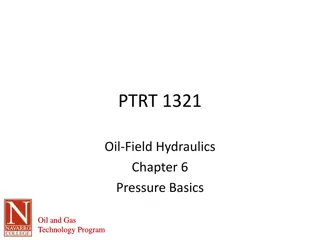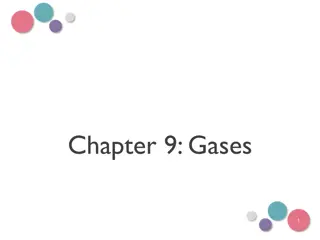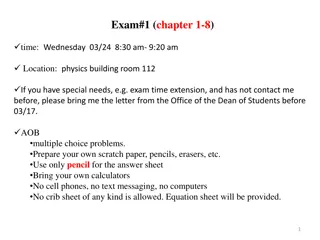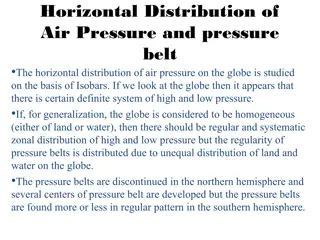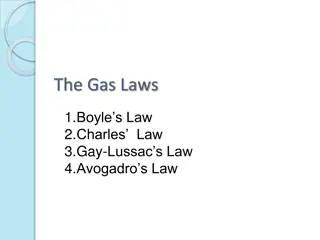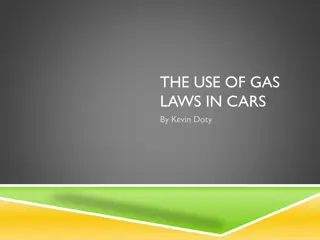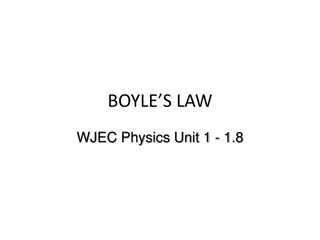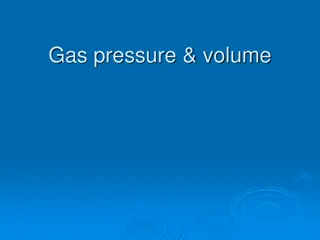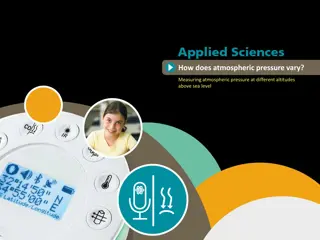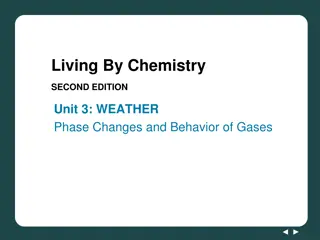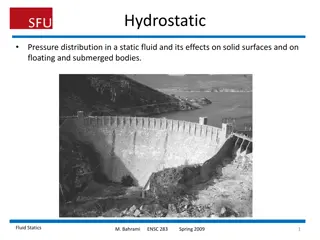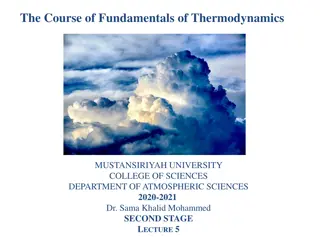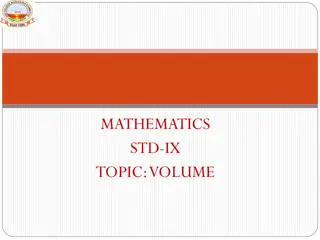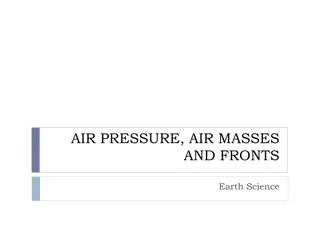Investigating Boyle's Law: The Relationship Between Air Pressure and Volume
Explore the fascinating relationship between air pressure and volume of a confined gas at constant temperature through an experiment testing Boyle's Law. Learn about the historical context and theoretical foundation behind the behavior of gases, including the concept of ideal gases and the Boyle-Marriot Ideal Gas Law. Discover the inverse proportional relationship between pressure and volume in an ideal gas, as studied by renowned scientists like Robert Boyle and Edme Marriot.
Download Presentation

Please find below an Image/Link to download the presentation.
The content on the website is provided AS IS for your information and personal use only. It may not be sold, licensed, or shared on other websites without obtaining consent from the author.If you encounter any issues during the download, it is possible that the publisher has removed the file from their server.
You are allowed to download the files provided on this website for personal or commercial use, subject to the condition that they are used lawfully. All files are the property of their respective owners.
The content on the website is provided AS IS for your information and personal use only. It may not be sold, licensed, or shared on other websites without obtaining consent from the author.
E N D
Presentation Transcript
Boyles law Verifying the relation between air pressure and volume measuring air pressure in a closed container. Objective The purpose of this activity is to analyze the relationship between the pressure and volume of a confined gas at constant temperature, create a hypothesis and proceed to test it using the SensorLab air pressure sensor.
Boyles law Verifying the relation between air pressure and volume measuring air pressure in a closed container. Introduction and theory Throughout the history of science many important scientists have devoted their work to the analysis and observation of natural phenomenon, and to its description through the development of mathematical formula. Their conclusions have gradually passed into universal knowledge. For example, Avogadro, Gay-Lussac, Charles Graham and Robert Boyle studied the behavior of ideal gases between the 17th and 19th centuries. These eminent scientists contributed to the understanding of ideal gases, and established the relationships between the variables that describe them.
Boyles law Verifying the relation between air pressure and volume measuring air pressure in a closed container. Introduction and theory Which variables do you think we should consider when studying the behavior of gases? Why do you think we talk about ideal gases? Carry out the experiment activity with your class so that at the end you ll be able to answer the following question: What is the relationship between the pressure and volume of a confined gas?
Boyles law Verifying the relation between air pressure and volume measuring air pressure in a closed container. Introduction and theory Theoretical We define pressure as a force applied by a body on a unit area, i.e: = / P F A Where P = pressure, F = force, A = area. Therefore, a gas confined to a small container will exert greater pressure upon the container walls, compared to a gas confined to a larger container. As the walls surface area decreases, the relationship force/area becomes greater.
Boyles law Verifying the relation between air pressure and volume measuring air pressure in a closed container. Introduction and theory Robert Boyle and Edme Marriot studied this concept, presenting the Boyle-Marriot Ideal Gas Law. The study of general chemistry applies the ideal gas concept in referring to hypothetic gases composed of non-interacting point particles that move randomly. This approach is a simplified way of studying gases, and allows us to predict their behavior. Boyle s Law states the inversely proportional relationship between the pressure and volume of an ideal gas at constant temperature. Therefore, the product of pressure and the volume is represented by a constant (k). PV = k
Boyles law Verifying the relation between air pressure and volume measuring air pressure in a closed container. Introduction and theory When we keep the temperature constant inside a closed system, with a fixed amount of gas, the before and after volume and pressure are represented by the following equation: Where: = P V P V 1 1 2 2 P = initial pressure V = initial volume P = final pressure V = final volume
Boyles law Verifying the relation between air pressure and volume measuring air pressure in a closed container. Introduction and theory Now students are encouraged to raise a hypothesis which must be tested with an experiment. If you have a confined gas inside a syringe and decrease the volume, how does the internal pressure change?
Boyles law Verifying the relation between air pressure and volume measuring air pressure in a closed container. Activity description Students will investigate the effect of volume changes on the pressure inside a syringe with a fixed amount of air at constant temperature. They will measure the air pressure and then proceed to build a graph plotting their results in order to analyze them.
Boyles law Verifying the relation between air pressure and volume measuring air pressure in a closed container. Resources and materials SensorLab Syringe Plastic tube 1 2 3
Boyles law Verifying the relation between air pressure and volume measuring air pressure in a closed container. Using the SensorLab SensorLab configuration To collect measurements with the SensorLab and thermocouple sensor, the SensorLab must be configured according to the following steps: Turn on the SensorLab . Press and select SETUP by pressing . Now select SET SENSORS by pressing and choose air pressure . On the setup menu, press and select SAMPLING RATE with .
Boyles law Verifying the relation between air pressure and volume measuring air pressure in a closed container. Using the SensorLab Select MANUAL with and then press three times to go back to the measurements and run the SensorLab pressing . Once you have finished measuring, stop the SensorLab by pressing (you will see the instruction press SCROLL key to STOP ) and press .
Boyles law Verifying the relation between air pressure and volume measuring air pressure in a closed container. Experiment Connect the syringe tip with the transparent head of the plastic tube and fill the syringe with air until 60 mL. Connect the plastic tube to the air pressure sensor screwing in the white head. Once completed start the measurements.
Boyles law Verifying the relation between air pressure and volume measuring air pressure in a closed container. Experiment Register the value of the pressure data volume of 60 mL. Then decrease the volume by 10 mL. by gently pushing the plunger. Wait until the measurements stabilize and register the pressure once again. Measure the pressure at points of 60, 50, 40 and 30 mL. of air inside the syringe and then stop the SensorLab.
Boyles law Verifying the relation between air pressure and volume measuring air pressure in a closed container. Results and analysis Connect the SensorLab to the computer using the USB communication cable or via the Bluetooth wireless communication channel. In the top menu click the button and select the button. Select the last experiment of the list. Observe the graph displayed on the screen and write notes on the graph by pressing ,, specifying your observations according to the moment you registered the data.
Boyles law Verifying the relation between air pressure and volume measuring air pressure in a closed container. Results and analysis Press the button, save the data on the computer and export to Excel. Add a third column with the air volume (in mL.) recorded at each measurement. Multiply the air pressure with the volume in each case and compare the values.
Boyles law Verifying the relation between air pressure and volume measuring air pressure in a closed container. Results and analysis Were there differences between what you expected and your actual results? What happens with the air pressure when you decrease the volume? Can you find any relation between the pressure and the volume of a gas in a closed container?
Boyles law Verifying the relation between air pressure and volume measuring air pressure in a closed container. Results and analysis The graph below should be similar to the one the students came up with:
Boyles law Verifying the relation between air pressure and volume measuring air pressure in a closed container. Conclusion Observe the relation between pressure and volume, as well as the characteristics of the values obtained in each case? Students should observe and compare the values obtained and indicate that they are relatively constant; which is explained by the Boyle s Law statement. What kind of pressure variation is observed when the plunger is down? Students should understand that when the plunger is down the gas volume is decreased and therefore the pressure increases. What happens with the closed system s conditions when its volume increases? Students should establish that lifting the plunger raises the volume inside the syringe, therefore lowering the pressure. This happens because a fixed number of air particles exert force against the sides of the container which now has increased the available space for them.
Boyles law Verifying the relation between air pressure and volume measuring air pressure in a closed container. Conclusion If you consider the Boyle s Law statement and observe the multiple of pressure and volume in each case, how do you explain the variation between them? Students should indicate certain variations that could influence the results, such as the pulse of the person who was measuring, the accuracy of the syringe, etc. What is the relationship between the volume and the air pressure of a gas in a closed container? Students should establish an inverse proportionality between the air pressure and volume. When the volume decreases, the pressure increases and vice versa. What do you think happens on a molecular level, that allows these pressure variations to occur? Students should relate the air pressure to the molecular movements of the air particles. The particles collide with other particles and with the walls of the container. At an increased volume there are fewer particles colliding in the same wall surface area, and therefore the pressure drops. If you reduce the space, the particles will collide more often, causing the pressure to rise.
Boyles law Verifying the relation between air pressure and volume measuring air pressure in a closed container. Conclusion Students should reach following conclusions: There is an inverse relationship between the volume and the pressure inside a closed container. This relationship is expressed by the Boyle-Marriot Law which tells us that at constant temperature the volume is inversely proportional to the pressure, and the product of both variables is constant. We can conclude from this that when you increase the volume, the pressure decreases; and when you decrease the volume the pressure increases.
Boyles law Verifying the relation between air pressure and volume measuring air pressure in a closed container. Activities for further application Consider an ideal gas at an initial pressure P1 of 1 [atm] and a volume V1 of 30 [l]. What is the final volume if the pressure increases to 2.5 atm? (T = constant) Students should put the Boyle-Marriot Law into practice and calculate the final volume V2 of the ideal gas. The correct answer is 12 liters. How would the pressure of a confined gas inside of a syringe vary, if we try to compress it as much as possible? Students should analyze the situation and understand that if we compress the air we reduce the volume, raising the pressure because of the inverse relationship of both variables.
Boyles law Verifying the relation between air pressure and volume measuring air pressure in a closed container. Activities for further application What is the purpose of considering ideal as opposed to real gases? Students should understand that a simple conceptual approach helps us to study and calculate the parameters of real gases behavior.


